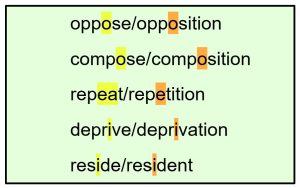7 Spelling – Schwa Vowels
Category: Spelling
Concept: Schwa vowels
Connections to The Ontario Curriculum, Grades 1-8: Language (2023)
_____B2. Language Foundations for Reading and Spelling
—-_____-B2.1 Word-Level Reading and Spelling
Prior Knowledge:
- Understanding the difference between vowels and consonants
- Understanding that syllables can be stressed or unstressed
What’s the definition?
A vowel that is unstressed, toneless, and neutral, occurring in unstressed syllables (e.g. a in about or o in synonym). Schwa vowels are the most common vowel sounds in the English language. They are often transcribed using an upside down e symbol. / Ə /
The Ontario Curriculum, Grades 1-8: Language (2023)
What does it look/sound like?
Schwa vowels sound like “uh,” in that they are not clearly pronounced. Listen to the difference in the vowel a as it is pronounced in apple (where it appears in the stressed syllable) vs. the sound of a in again, where it is in the unstressed syllable.
Compare the sound of o in the first syllable of bottom, where it is stressed, with the second syllable, where it is unstressed.
Why does it matter?
Students often learn to sound words out for spelling. Unfortunately, this strategy does not work with schwa vowels, as they all tend to sound like “uh.” Note the similar pronunciations of the schwa vowels in these words: lesson; lessen; margin.
As students progress through the grades, they encounter and use longer words, and therefore are exposed to more schwa vowels. This becomes a challenge for spelling and students may resort to using simple words to avoid making multiple spelling errors in their writing.
Help students to understand that sounding words out may not always be a satisfactory approach to spelling.
How do I teach this?
Related forms of words
One useful trick for spelling schwa vowels is to look for a shorter version of the word where the vowel is sounded. In derived forms, the base word is often stressed and therefore the vowels are easier to hear. Listen to the sound of i in the base form define as opposed to the derived form definition. If students mentally think of the base form or a related form of many longer words, the spelling of the schwa is much easier.
Visual Memory
Students can also use visual memory to help them remember the spelling of schwa vowels.
Read aloud the list of words above. Emphasize the difference in vowel sound from the base word and its derived form. Have students highlight the vowel in both forms of the word to activate their visual memory.
In addition, they can highlight the vowels in their writing that give them difficulty.

Cross-Curricular Connections
Point out related words and derived forms in a variety of subject areas. Academic vocabulary becomes more complex in later grades, with a corresponding increase in schwa vowels.
Mathematics: geometry / geometric
octagon/ octagonal
Social Studies: Canada / Canadian
democracy / democratic
immigrant/ immigration
Everyday applications
Challenge students to brainstorm food words that contain schwa vowels. e.g. bacon; carrots; apricot; banana; pretzel; lemon; salad.
Alternatively, provide pictures and have students identify the pictures and then spell the word. Have them try to identify the schwa sound in the word.
Online Resources
The Schwa Sound (the most common vowel sound) YouTube 5:52
https://youtu.be/yWGCPXPkqG0?si=Gl2VxfXUKJWu2yg8
A derived form, or derivation, is the new word that is created from a base or a base word.
Example:
From the base -ject, we can create derivations, including inject, reject, dejection, etc.
A structural element that forms the foundation of a written word; any unit of a word to which affixes can be added. (e.g., act is the base of acted, action, activity, activate, react). Types of bases include:
bound base. A base that requires an affix to form a word (e.g., -ject in inject and project).
free base. A base that forms a word on its own (e.g., eat, date, weak).

